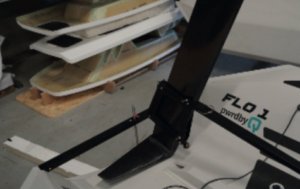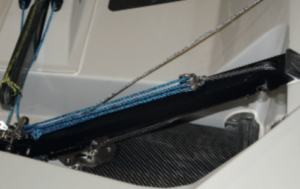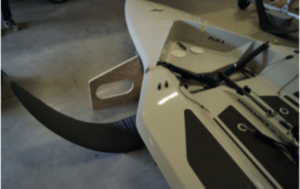Foiling article in German magazine Palstek
Jurian Rademaker is the owner of Aeronamics (PwrdbyQ) and Qconcepts Design & Engineering and is an expert in the field of composite materials. He has given his technical view about the foiling developments which are described in this article of the German magazine Palstek, written by Jan Kuffel. From his contributions to the construction of the Volvo 70 boats for Team ABN-AMRO to the establishment of Qconcepts Design & Engineering in Doetinchem, Jurian Rademaker has left a trail of innovation. This article showcases his insights and technical contributions, highlighting his expertise in foiling across various projects, including the remarkable design of the Flo1, a flying single-handed sailboat under the label Aeronamics.
The technical challenges inherent in foiling technology already seem to address the question of whether cruising yachts will learn to fly in the near future. The foiling technology is complex on large ocean racers, resulting in high costs, demanding maintenance, and practically unusable without a professional crew and onshore support. Therefore, this technology on these larger boats is likely to find only solid ground in the Grand Prix circuits in the long run. Additionally, the foils, canting keels, and their below-deck control and steering components take up a lot of space. Furthermore, the boats are incredibly noisy below deck, and the boats endure extreme accelerations and decelerations. All of these factors make it challenging to combine this technology with conventional boats designed to appeal to a wide audience.
The rudder blade is housed in a cassette and can be easily raised by hand: the perspective is adjustable and determines the boat’s height.
The hydrofoils are adjusted using pulleys, which operates with one hand and appears uncomplicated. Even beginners can learn to fly in just 15 minutes.
However, the situation is fundamentally different for dinghies and small multihulls. The line between leisure and sport is not clearly defined in these types of boats. New foiling classes such as the two-person sailboat Peacoq or the catamaran Befoil are emerging rapidly. Both made their debut at the recent Boot Düsseldorf fair. A leading developer in this category is Jurian Rademaker, who provided advice for this article. He is a passionate speed enthusiast and a recognized composites expert, contributing to the construction of the Volvo 70 boats from Team ABN-AMRO.
Subsequently, Jurian Rademaker expanded his company, Qconcepts Design & Engineering, in Doetinchem to develop multiple performance projects. These include the canting keel sport yacht CQ6, foiling – rowing and electric boats, and not least, a flying single-handed sailboat, the Flo1.
The Flo1 is built in series under the label Aeronamics. In addition, work is underway on a 20-foot foiler, while a 30-foot foiler is in the planning phase. Jurian Rademaker considers foiling to be the best way to keep sailing interesting for future generations, partly due to its speed. He states: “Today’s youth is growing up in a fast-paced world, as seen in YouTube videos. Life involves unexpected and rapid twists, leaving little time for personal activities and hobbies, as they must compete with many other obligations. In this context, fast foilers fit very well into the current era, provided that we manage to substantially simplify the technology and make it accessible to a wider audience. That is one of our design approaches for the Flo1.”
”Life involves unexpected and rapid twists.”
Light and yet stiff – hydrofoils and rudders are made from carbon prepregs using a vacuum process.
Anyone who has mastered an ILCA/Laser reasonably can handle our Flo1 foiling boat within 15 minutes and will immediately have a lot of fun with it. You do not need to be a top athlete: we deliberately designed the boat to be as simple as possible, making it suitable for use by sailing schools nowadays. Besides the hull design, a significant part of the development naturally went into the hydrofoils. We use a central centerboard and adapted DSS hydrofoils that provide a lot of stability to the boat.
Even when the hydrofoils are raised, the boat maintains a stable floating position like a regular non-foiling sailboat. This makes launching from the beach easy, and docking at the dock is not a problem. Sailing in non-foiling mode works as usual, from 8 to 9 knots of wind, the hydrofoils can be lowered, and the boat flies almost silently and stable above the water. Besides the sheet and tart, only the simple adjustment of the foils via a pulley system is needed, which people get used to quickly’’.
‘’The key to fast and easy foiling here also lies in the lightweight construction. The easily to rig carbon fiber mast adds minimal weight. The foils and the stabilizing rear foil on the rudder are also made of carbon. In contrast, the hull and deck are manufactured from fiberglass and epoxy resin, with carbon reinforcements in highly stressed areas. All of this may not lure a seasoned ‘top athlete’ to a foiling boat, but it does make this exciting form of sailing accessible to a wider and younger audience. Anyone who has tried the Flo1 can agree on at least one point – foiling or even flying brings immense joy’’.
”The easily riggable carbon fiber mast adds minimal weight.”
The Flo1 has a sporty appearance, but the equipment and trimming features are significantly reduced, making the boat easy to use. A fairly wide hull provides stability, even at rest.
Similarities with the Contender and other single-handed boats are certainly not accidental, but the Flo1 is significantly easier to sail.
This article is published in Palstek magazine and written by Jan Kuffel.





